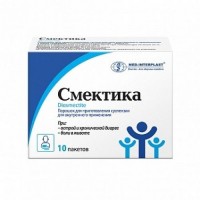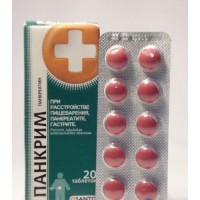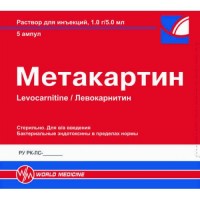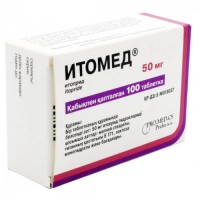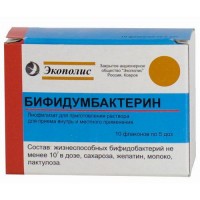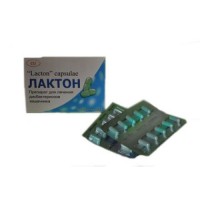It loperamide hydrochloride 2 mg (10 capsules)
- $2.50
The instruction for medical use
of medicine
of Loperamide a hydrochloride
the Trade name
of Loperamide a hydrochloride
the International unlicensed
name Loperamide Dosage Form
of the Capsule of 2 mg
Structure
One capsule contains
active agent of loperamide a hydrochloride (in terms of 100% substance) 2 mg,
excipients: magnesium stearate, corn starch, lactoses monohydrate,
structure of a cover of the capsule: gelatin, glycerin, methylparahydroxybenzoate, propilparagidroksibenzoat, sodium lauryl sulfate, the titan dioxide (E 171), the water purified.
The description
gelatinous solid capsules of a cylindrical form with the hemispherical ends of color No. 0, white or white with a yellowish shade. Contents of capsules - granulate from white till slightly yellowish color.
Pharmacotherapeutic group
Antidiarrheal means. The drugs reducing motility of digestive tract. Loperamide.
ATX A07DA03 code
Pharmacological
Pharmacokinetics Absorption properties of loperamide of a hydrochloride of 40%. The maximum concentration in blood plasma is reached in 2.5 h. Communication with proteins of plasma (mainly with albumine) 97%. Does not get through a blood-brain barrier. Is exposed to intensive metabolism in the course of oxidizing N-demethylation at the first passing through a liver. It is almost completely metabolized by a liver by conjugation. Elimination half-life makes 9-14 h (on average 10.8 h). It is removed mainly with bile, an insignificant part is removed by kidneys (in the form of the conjugated metabolites).
The Loperamide pharmacodynamics a hydrochloride, contacting opioid receptors of an intestinal wall (stimulation sincaline - and adrenergic neurons through guanine nucleotides), reduces a tone and motility of smooth muscles of intestines (at the expense of inhibition of release of acetylcholine and Pg). Slows down a vermicular movement and increases time of passing of intestinal contents. Raises a tone of an anal sphincter, promotes deduction of stool and an urezheniye of desires to defecation. Action develops quickly and continues 4-6 h. Unlike opiates, loperamide does not possess the central action as does not get through a blood-brain barrier, does not cause addiction and accustoming, is more selective on action therefore it causes smaller number of by-effects.
Indications
- symptomatic treatment of acute and chronic non-infectious diarrhea at adults and children are more senior than 12 years
the Route of administration and doses
of the Capsule accept inside, without chewing, washing down with water.
Acute diarrhea
the Initial dose for adults makes 2 capsules (4 mg). Further accept on 1 capsule (2 mg) after each act of defecation in case of a liquid chair. To children 12 years are more senior appoint in an initial dose 2 mg, further on 2 mg after each act of defecation in case of a liquid chair.
The maximum daily dose should not exceed 16 mg (8 capsules).
The dosage has to be regulated according to result next day, the maximum daily dose should not exceed a dose of the first day.
In chronic diarrhea
the Initial daily dose for adults makes 2 capsules (4 mg). This dose is usually individually adjusted subsequently so that the frequency of a chair was 1-2 times a day that is usually reached at a maintenance dose from 1 to 6 capsules in day. The maximum daily dose in acute and chronic diarrhea the adult 16 mg (8 capsules), at children have 6 mg on 20 kg of body weight - up to 16 mg.
At emergence of a normal chair or in the absence of a chair more than 12 hours cancel administration of drug.
Side effects
classified the listed side effects as follows, very frequent Below (& gt, 10%), frequent (& gt, 1% and & lt, 10%), infrequent (& gt, 0.1% and & lt, 1%), rare (& gt, 0.01% and & lt, 0.1%) and very rare (& lt, 0.01%), including isolated cases.
Often
- dryness in a mouth, nausea, vomiting, a gastralgia, pain and discomfort in a stomach, a meteorism, dyspepsia, intestinal colic, constipations
- fatigue, drowsiness, insomnia, a headache, dizziness, an oppression/loss of consciousness, spasms, a tremor
- allergic reactions (skin rash)
- electrolytic disturbances
Seldom
- an ischuria
- bullous rash, Stephens-Johnson's syndrome, a multiformny erythema, a toxic epidermal necrolysis
Very seldom
- a hypovolemia
- paralytic intestinal impassability, the accelerated formation of toxic megacolon
- the acute anaphylaxis and anaphylactoid reactions
of the Message about adverse reactions during clinical and post-market researches of loperamide are typical for a sharp diarrheal syndrome (abdominal pain / discomfort, nausea, vomiting, dryness in a mouth, fatigue, drowsiness, dizziness, constipations and swelling). Therefore it is usually quite difficult to establish a causal relationship between intake of loperamide and emergence of the listed symptoms.
Contraindications
- hypersensitivity to loperamide or other components of medicine
- the acute dysentery and other infections of digestive tract (caused, including Salmonella spp., Shigella spp., Campylobacter spp.)
- intestinal impassability (including if necessary to avoid suppression of a vermicular movement)
- a divertuculosis
- acute ulcer colitis
- a pseudomembranous coloenteritis (the diarrhea caused by reception of antibiotics)
- hereditary intolerance of a galactose, lactose, a sprue, a glyukozemiya, a galactosemia
- pregnancy and the period of a lactation
- children's age up to 12 years
Medicinal interactions
except for the drugs possessing similar pharmacological action because of possible mutual strengthening of effect, interaction with other medicines it is not revealed.
The special
instructions Intake of Medicine need to be stopped immediately if the constipation or an abdominal distension develops.
As treatment of diarrhea loperamide has only symptomatic character, along with it it is necessary to apply etiotropic means, whenever possible.
In diarrhea, especially children, can have a hypovolemia and decrease in content of electrolytes. In such cases of the most important the replacement therapy for completion of liquid and electrolytes is.
In acute diarrhea if during 48 h the clinical improvement is not observed, intake of loperamide it is necessary to stop and exclude infectious genesis of diarrhea.
Not to apply in diarrhea with blood impurity in a chair and high temperature.
At patients AIDS it is necessary to stop immediately treatment at the first symptoms of an abdominal distension. In some cases at patients AIDS with infectious colitis of the virus and bacterial nature at treatment with loperamide can develop toxic megacolon.
At treatment of patients with renal failures there is no need to reduce a loperamide dose.
During treatment the observance of a diet and completion of liquid is recommended.
Use in pediatrics
to Children from 4 to 12 years is not recommended to appoint loperamide in capsules, the recommended dosage form - solution for intake.
Use in abnormal liver functions
With care it is necessary to appoint drug in a liver failure. Patients with an abnormal liver function have to be under careful observation for the purpose of early detection of signs of toxic damage of the central nervous system.
The feature of influence on ability to run the vehicle and potentially dangerous mechanisms
during treatment needs to refrain from driving of transport and occupations potentially dangerous types of activity demanding the increased concentration of attention and high speed of psychomotor reactions.
Overdose
Symptoms: oppression of the central nervous system (stupor, lacks of coordination of movements, drowsiness, miosis, muscular hypertension, respiratory depression), intestinal impassability.
Treatment: gastric lavage, prescribing of activated carbon (not later than in 3 h after intake of loperamide), if necessary - artificial ventilation of the lungs, performing symptomatic therapy. Antidote - Naloxonum. As duration of effect of loperamide is more, than at Naloxonum (1 - 3 h), repeated appointment of the last can be required. For identification of possible oppression of the central nervous system it is necessary to watch closely a condition of the patient not less than 48 h.
A form of release and packing
On 10 capsules in blister strip packaging from a film of the polyvinylchloride and printing aluminum foil varnished.
Blister strip packagings (without investment in a pack) together with the corresponding number of instructions for medical use in the state and Russian languages in a box of cardboard.
On the 2nd blister strip packagings together with the instruction for medical use in the state and Russian languages in a pack from cardboard.
To Store storage conditions in the dry, protected from light place, at a temperature from 15 With up to 25 C.
To protect from children.
2 years
not to use a period of storage after an expiration date.
Prescription status
According to the prescription
the Open joint stock company Producer the Borisovsky plant of medications, Republic of Belarus, Minsk Region, Borisov, Chapayev St., 64/27,
ph. / fax 8-(10375177) 744280.
The owner of the registration certificate
Open joint stock company the Borisovsky plant of medications, Republic of Belarus
To develop the Address of the organization accepting in the territory of the Republic of Kazakhstan claims from consumers on quality of products (goods) Open joint stock company the Borisovsky plant of medications, Republic of Belarus, Minsk Region, Borisov, Chapayev St., 64/27, ph. / fax 8-(10375177) 744280, the e-mail address of market@borimed.com
of medicine
of Loperamide a hydrochloride
the Trade name
of Loperamide a hydrochloride
the International unlicensed
name Loperamide Dosage Form
of the Capsule of 2 mg
Structure
One capsule contains
active agent of loperamide a hydrochloride (in terms of 100% substance) 2 mg,
excipients: magnesium stearate, corn starch, lactoses monohydrate,
structure of a cover of the capsule: gelatin, glycerin, methylparahydroxybenzoate, propilparagidroksibenzoat, sodium lauryl sulfate, the titan dioxide (E 171), the water purified.
The description
gelatinous solid capsules of a cylindrical form with the hemispherical ends of color No. 0, white or white with a yellowish shade. Contents of capsules - granulate from white till slightly yellowish color.
Pharmacotherapeutic group
Antidiarrheal means. The drugs reducing motility of digestive tract. Loperamide.
ATX A07DA03 code
Pharmacological
Pharmacokinetics Absorption properties of loperamide of a hydrochloride of 40%. The maximum concentration in blood plasma is reached in 2.5 h. Communication with proteins of plasma (mainly with albumine) 97%. Does not get through a blood-brain barrier. Is exposed to intensive metabolism in the course of oxidizing N-demethylation at the first passing through a liver. It is almost completely metabolized by a liver by conjugation. Elimination half-life makes 9-14 h (on average 10.8 h). It is removed mainly with bile, an insignificant part is removed by kidneys (in the form of the conjugated metabolites).
The Loperamide pharmacodynamics a hydrochloride, contacting opioid receptors of an intestinal wall (stimulation sincaline - and adrenergic neurons through guanine nucleotides), reduces a tone and motility of smooth muscles of intestines (at the expense of inhibition of release of acetylcholine and Pg). Slows down a vermicular movement and increases time of passing of intestinal contents. Raises a tone of an anal sphincter, promotes deduction of stool and an urezheniye of desires to defecation. Action develops quickly and continues 4-6 h. Unlike opiates, loperamide does not possess the central action as does not get through a blood-brain barrier, does not cause addiction and accustoming, is more selective on action therefore it causes smaller number of by-effects.
Indications
- symptomatic treatment of acute and chronic non-infectious diarrhea at adults and children are more senior than 12 years
the Route of administration and doses
of the Capsule accept inside, without chewing, washing down with water.
Acute diarrhea
the Initial dose for adults makes 2 capsules (4 mg). Further accept on 1 capsule (2 mg) after each act of defecation in case of a liquid chair. To children 12 years are more senior appoint in an initial dose 2 mg, further on 2 mg after each act of defecation in case of a liquid chair.
The maximum daily dose should not exceed 16 mg (8 capsules).
The dosage has to be regulated according to result next day, the maximum daily dose should not exceed a dose of the first day.
In chronic diarrhea
the Initial daily dose for adults makes 2 capsules (4 mg). This dose is usually individually adjusted subsequently so that the frequency of a chair was 1-2 times a day that is usually reached at a maintenance dose from 1 to 6 capsules in day. The maximum daily dose in acute and chronic diarrhea the adult 16 mg (8 capsules), at children have 6 mg on 20 kg of body weight - up to 16 mg.
At emergence of a normal chair or in the absence of a chair more than 12 hours cancel administration of drug.
Side effects
classified the listed side effects as follows, very frequent Below (& gt, 10%), frequent (& gt, 1% and & lt, 10%), infrequent (& gt, 0.1% and & lt, 1%), rare (& gt, 0.01% and & lt, 0.1%) and very rare (& lt, 0.01%), including isolated cases.
Often
- dryness in a mouth, nausea, vomiting, a gastralgia, pain and discomfort in a stomach, a meteorism, dyspepsia, intestinal colic, constipations
- fatigue, drowsiness, insomnia, a headache, dizziness, an oppression/loss of consciousness, spasms, a tremor
- allergic reactions (skin rash)
- electrolytic disturbances
Seldom
- an ischuria
- bullous rash, Stephens-Johnson's syndrome, a multiformny erythema, a toxic epidermal necrolysis
Very seldom
- a hypovolemia
- paralytic intestinal impassability, the accelerated formation of toxic megacolon
- the acute anaphylaxis and anaphylactoid reactions
of the Message about adverse reactions during clinical and post-market researches of loperamide are typical for a sharp diarrheal syndrome (abdominal pain / discomfort, nausea, vomiting, dryness in a mouth, fatigue, drowsiness, dizziness, constipations and swelling). Therefore it is usually quite difficult to establish a causal relationship between intake of loperamide and emergence of the listed symptoms.
Contraindications
- hypersensitivity to loperamide or other components of medicine
- the acute dysentery and other infections of digestive tract (caused, including Salmonella spp., Shigella spp., Campylobacter spp.)
- intestinal impassability (including if necessary to avoid suppression of a vermicular movement)
- a divertuculosis
- acute ulcer colitis
- a pseudomembranous coloenteritis (the diarrhea caused by reception of antibiotics)
- hereditary intolerance of a galactose, lactose, a sprue, a glyukozemiya, a galactosemia
- pregnancy and the period of a lactation
- children's age up to 12 years
Medicinal interactions
except for the drugs possessing similar pharmacological action because of possible mutual strengthening of effect, interaction with other medicines it is not revealed.
The special
instructions Intake of Medicine need to be stopped immediately if the constipation or an abdominal distension develops.
As treatment of diarrhea loperamide has only symptomatic character, along with it it is necessary to apply etiotropic means, whenever possible.
In diarrhea, especially children, can have a hypovolemia and decrease in content of electrolytes. In such cases of the most important the replacement therapy for completion of liquid and electrolytes is.
In acute diarrhea if during 48 h the clinical improvement is not observed, intake of loperamide it is necessary to stop and exclude infectious genesis of diarrhea.
Not to apply in diarrhea with blood impurity in a chair and high temperature.
At patients AIDS it is necessary to stop immediately treatment at the first symptoms of an abdominal distension. In some cases at patients AIDS with infectious colitis of the virus and bacterial nature at treatment with loperamide can develop toxic megacolon.
At treatment of patients with renal failures there is no need to reduce a loperamide dose.
During treatment the observance of a diet and completion of liquid is recommended.
Use in pediatrics
to Children from 4 to 12 years is not recommended to appoint loperamide in capsules, the recommended dosage form - solution for intake.
Use in abnormal liver functions
With care it is necessary to appoint drug in a liver failure. Patients with an abnormal liver function have to be under careful observation for the purpose of early detection of signs of toxic damage of the central nervous system.
The feature of influence on ability to run the vehicle and potentially dangerous mechanisms
during treatment needs to refrain from driving of transport and occupations potentially dangerous types of activity demanding the increased concentration of attention and high speed of psychomotor reactions.
Overdose
Symptoms: oppression of the central nervous system (stupor, lacks of coordination of movements, drowsiness, miosis, muscular hypertension, respiratory depression), intestinal impassability.
Treatment: gastric lavage, prescribing of activated carbon (not later than in 3 h after intake of loperamide), if necessary - artificial ventilation of the lungs, performing symptomatic therapy. Antidote - Naloxonum. As duration of effect of loperamide is more, than at Naloxonum (1 - 3 h), repeated appointment of the last can be required. For identification of possible oppression of the central nervous system it is necessary to watch closely a condition of the patient not less than 48 h.
A form of release and packing
On 10 capsules in blister strip packaging from a film of the polyvinylchloride and printing aluminum foil varnished.
Blister strip packagings (without investment in a pack) together with the corresponding number of instructions for medical use in the state and Russian languages in a box of cardboard.
On the 2nd blister strip packagings together with the instruction for medical use in the state and Russian languages in a pack from cardboard.
To Store storage conditions in the dry, protected from light place, at a temperature from 15 With up to 25 C.
To protect from children.
2 years
not to use a period of storage after an expiration date.
Prescription status
According to the prescription
the Open joint stock company Producer the Borisovsky plant of medications, Republic of Belarus, Minsk Region, Borisov, Chapayev St., 64/27,
ph. / fax 8-(10375177) 744280.
The owner of the registration certificate
Open joint stock company the Borisovsky plant of medications, Republic of Belarus
To develop the Address of the organization accepting in the territory of the Republic of Kazakhstan claims from consumers on quality of products (goods) Open joint stock company the Borisovsky plant of medications, Republic of Belarus, Minsk Region, Borisov, Chapayev St., 64/27, ph. / fax 8-(10375177) 744280, the e-mail address of market@borimed.com

